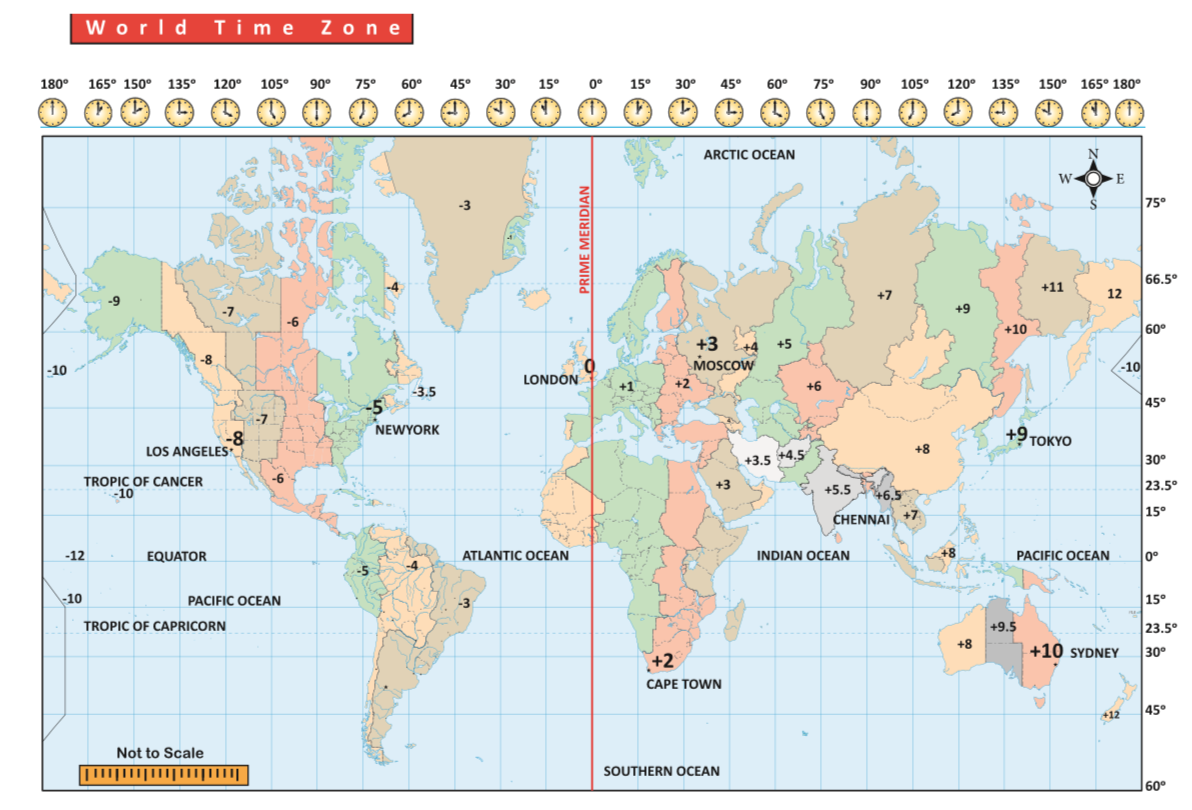Globe Notes 6th Social Science
Globe Notes 6th Social Science
6th Social Science Lesson 20 Notes in English
20. Globe
1. What are the four Major Cardinal Direction:
North, South, East and West are the Major cardinal Direction.
2. What is Globe?
In order to see the shape of the Earth as a whole and to know its unique features, a three dimensional model of the Earth was created with a specific scale.
3. The surface area of the Earth is 510.1 million square kilometres.
4. Why earth is Geoid?
The Earth which is spherical, is flat at the poles and bulges at the Equator. The Earth cannot be compared with any other geometrical shape as it has a very unique shape. Hence, its shape is called a geoid (earth shaped).
5. What is Inclination?
The Earth moves around the Sun. It also rotates from the West to East on its axis at an inclination of 23 ½°. The globe is also inclined at an angle of 23 ½°. The axis is an imaginary line. It is not actually found on the Earth.
6. What is Equator?
The imaginary lines which are drawn horizontally on East – West direction on the Earth are called the lines or parallels of latitudes. The 0° line of latitude which divides the Earth into two halves is known as the Equator.
6th Social Book Back Questions
7. What is the latitudinal Extent?
The latitudinal extent between 1° line of latitude on Earth is 111 km.
8. What are Latitudes and longitudes?
There are imaginary lines which are drawn on the globe horizontally and vertically to find a location and calculate distance and time. These imaginary lines are called lines of latitudes and longitudes.
9. Define Northern and Southern Latitudes:
The lines of latitude that are drawn horizontally between the Equator and the North Pole are called ‘Northern latitudes’ and those which are found between the Equator and the South Pole are called ‘Southern Latitudes’.
10. How many Latitude Lines are there?
The lines of latitude consist of 89 parallels in the Northern Hemisphere and 89 parallels in the Southern Hemisphere, one at the Equator and the two poles are found as points. Totally, there are 181 parallels found on earth.
11. Define Northern Hemisphere:
The area of the Earth found between the Equator (0°)) and the North Pole (90°N) is called the Northern Hemisphere.
12. Define Southern Hemisphere:
The area of the Earth from the equator (0°) to the South Pole (90°S) is called the Southern Hemisphere.
13. Why Climatic Zones are Formed?
- The Sun’s rays do not fall equally on all parts of the earth. They fall vertically over the Equator and slanting towards the poles.
- Thus, all the places on earth do not have the same amount of temperature.
- Based on the amount of heat received from the Sun, the lines of latitude help in dividing the earth into different climatic zones.
14. Define Torrid Zone:
The region from the Equator towards the Tropic of Cancer (23½°N) and the Tropic of Capricorn (23½°S) is called the Torrid Zone. The Sun’s rays fall vertically over this region and the average temperature is very high. Hence this region is known as the Torrid Zone.
15. What is Temperate Zone?
From the Tropic of Cancer (23½°N) to the Arctic Circle (66½°N) and from the Tropic of Capricorn (23½°S) to the Antarctic Circle (66½°S), the Sun’s rays fall slantingly. Moderate temperature prevails in this region. Hence, this region is called Temperate Zone.
16. What is Frigid Zone?
From the Arctic Circle (66½°N) to the North Pole (900N) and from the Antarctic Circle (66½°S) to the South Pole (90°S), the Sun’s rays fall further inclined, through out the year. The temperature is very low. Hence, this region is known as Frigid Zone.
17. What is Prime Meridian?
The imaginary lines drawn vertically connecting the North Pole and the South Pole are called lines or meridians of longitude. These lines of longitude are seen as semi circles. The 0° line of longitude is called the Prime Meridian.
18. How Many Lines are there in Longitude?
There are 180 lines of longitude towards the East and West from the Prime Meridian. So, there are totally 360 lines of longitude. These lines converge at the poles. The 180° W and 180° E line of longitude are the same line.
19. What are Eastern and Western Longitude?
The lines of longitude that are found between the Prime Meridian and the 180° East line of longitude are called ‘Eastern Longitudes’ and the lines of longitude that are found between the Prime Meridian (0°) and the 180° West line of longitude are called ‘Western Longitudes’.
20. What forms the Great Circle?
Two opposite meridians form a great circle. The Equator is the longest of all lines of latitude. Hence, it is also known as ‘The Great Circle’.
21. Define Eastern Hemisphere:
The part of the Earth between the 0° line of longitude and the 180° East line of longitude is known as the Eastern Hemisphere.
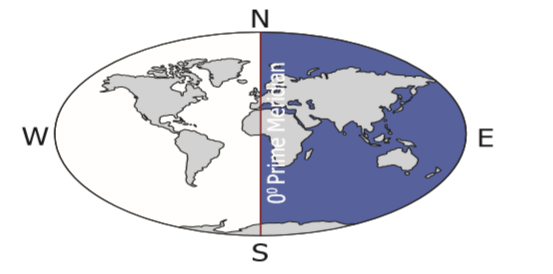
22. Define Western Hemisphere:
The part of the Earth from 0° line of longitude to 180° West line of longitude is called as Western Hemisphere.
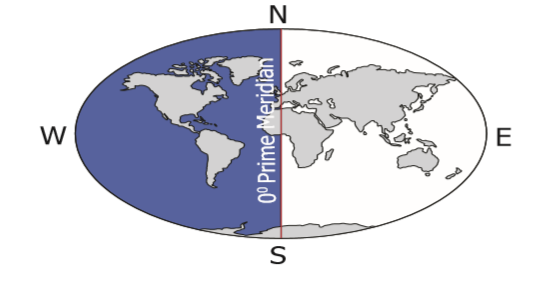
23. What is Greenwich Meridian?
- The Royal Astronomical Observatory is located at Greenwich near London in England.
- According to the International Meridian Conference held in 1884 in Washington DC in the U.S.A. all nations agreed on choosing the Greenwich Meridian as the international standard meridian (0°).
- This line of longitude is called the Prime Meridian and it is also known as the Greenwich Meridian because it passes through Greenwich.
24. What is International Date Line?
The 180° line of longitude has been fixed as the International Date Line, drawn on the Pacific Ocean between Alaska and Russia through Bering Strait. If a person crosses this line from the West to East, he loses a day. On the other hand, when he crosses from the East to West, he gains a day.
25. Define Earth Grid:
The imaginary lines of latitude and longitude form a grid like pattern on the surface of the earth, known as the ‘Earth grid’ or ‘Geographic grid’.
26. How time is Calculated?
As many as 360 lines of longitude are drawn to connect the North and South Poles around the Earth 180° on the Eastern Hemisphere and 180° on the Western Hemisphere. Time is calculated on the basis of the lines of longitude.
27. What is Local time?
When the sun is overhead on a particular line of longitude, it is 12 noon at all the places located on that line of longitude. This is called local time.
28. What is Greenwich Mean Time?
When the Sun is overhead the Greenwich Meridian at 12 noon, it is the local time of that place. The world time is calculated by this standard line of longitude. It is known as the Greenwich Mean Time (GMT).
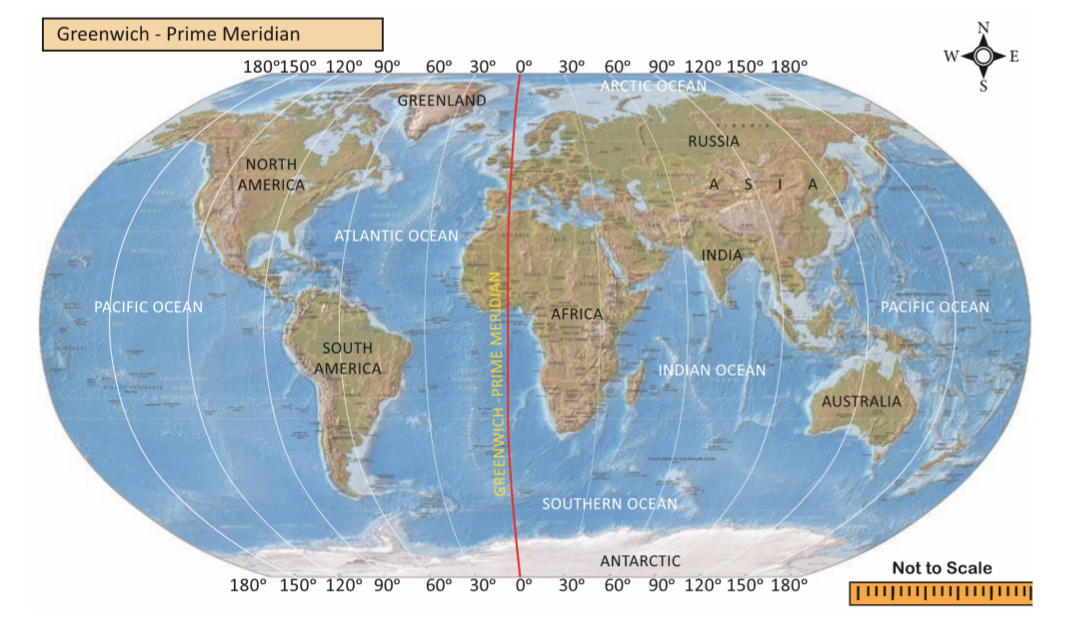
29. How different Countries Calculate their time?
Many lines of longitude may pass through a country. Countries may or may not observe a common time. The standard time of a country or a part of it is calculated keeping a particular meridian as a standard one.
30. How Meridians are Selected?
The meridians are selected in multiples of 15° or 7 ½°. It is done in such a way that the variation of standard time from the Greenwich is expressed either as 1 hour or ½ an hour.
31. What is Indian Standard Time?
- The longitudinal extent of India is from 68°7’ E to 97°25’ E.
- As many as twenty nine lines of longitude pass through India.
- Having 29 standard time is not logical.
- Hence 82½° E line of longitude is observed as the Prime Meridian to calculate the Indian Standard Time (IST).
32. How Many time Zones are there?
The world has 24 time zones. Some countries have a great longitudinal extent. So they have more than one standard time. Example: Russia has 7 time zones.
33. The 82½° E line of longitude passes through Mirzapur near Allahabad in Uttar Pradesh. This is located at an equal distance from Ghuar Mota in Gujarat and Kibithu in Arunachal Pradesh.
34. What does the word Meridian Mean?
- The word meridian is derived from the Latin word ‘Meridianus’. It means mid day. (Medius – Middle, dies – day). So, meridian means the position of the Sun found overhead at a place at noon.
- a.m. means ‘anti Meridiem’ (anti – before) -Before Noon.
- p.m. means ‘post Meridiem’ (Post -after/later) – After noon.
35. Why International Date line Zig-zag?
The International Date Line is not straight. If the line is drawn straight, two places in the same country would have different dates. So the International Date Line is found zigzag in certain places to avoid confusion.
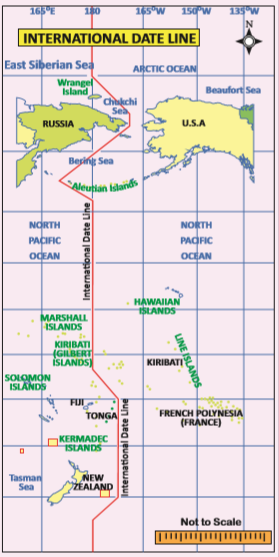
36. The lines of longitude are found as semi circles covering 111 km at the Equator, 79 km at 45° latitude and no space between the lines at the poles.
36. Some lines of latitude are also called by the following names in Tamil:
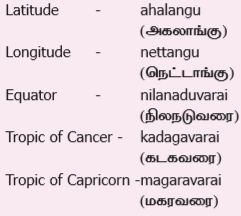
37. What are Low High and Middle latitudes?
- 0° N and S – 23½°N and S lines of latitudes are called -Low latitudes
- 23½°N and S – 66½°N and S lines of latitudes are called – Middle Latitudes
- 66½°N and S – 90°N and S lines of latitudes are called – High Latitudes
38. The first globe was created by the Greeks in the year 150 AD(CE).
39. Mention the Book of Aryabhatta:
The Indian astronomer Aryabhatta – has mentioned in his book. ‘Aryabhatta Sidhantha’. ‘The stars in the sky seem to move towards the West because of the Earth’s rotation on its axis’.
40. Ptolemy, a Greco – Roman mathematician, astronomer and geographer, was the first person to draw the lines of latitude and longitude on a map. In his book, ‘Geographia’ a detailed description about the Earth’s surface, its size and circumference and many locations based on the lines of latitude and longitude are given.
41. Show the Various Zones of the Earth:
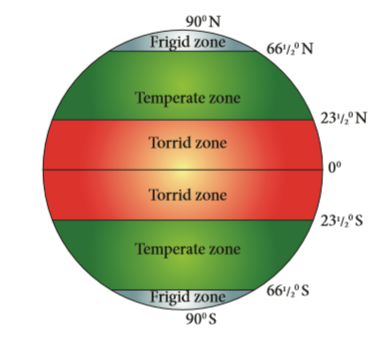
42. Time Zone:
